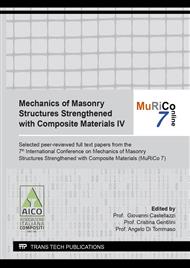p.352
p.361
p.369
p.377
p.385
p.393
p.401
p.409
p.417
Load Bearing Capacity of Masonry Arch Constructed by Means of a Patented Method: A Preliminary Study
Abstract:
Arch is a structural member which provides aesthetic beauty to architectures and, at the same time, guarantees stability to structures. For this reason, it was largely adopted for masonry building in the past centuries. Nonetheless, the erection of new curved structures is poorly considered in modern time. One of the possible causes is the difficulty of constructing since it requires the use of temporary scaffolding. Thus, it may results time-and cost-consuming. Innovation in the field of arch construction is very rare until now. The present paper aims to validate a novel construction method for curved members by means of small-scaled specimens. The proposed method consists of connecting the stone blocks on one side with Fibre Reinforced Polymer (FRP) and then lift it up. The herein experimental program involved masonry arches loaded at the mid-line in order to compare the behaviour of the traditionally-made and the innovative arches in terms of load-bearing versus deflection. This is a preliminary test within a larger ongoing experimental campaign.
Info:
Periodical:
Pages:
385-392
Citation:
Online since:
April 2022
Authors:
Price:
Сopyright:
© 2022 Trans Tech Publications Ltd. All Rights Reserved
Share:
Citation:


